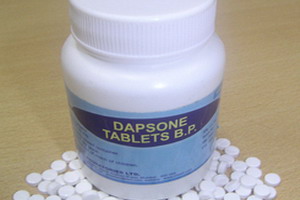 The dapsone, or sulfone-mother, is synthesized by e. Fromm and j. Witmann in 1908. In 1937 Ernest furnace France and g. Buttle at the United Kingdom discover, independently of the other, the antibacterial action of sulfones and two years later, in 1939, Christmas Rist demonstrates that they are efficient, in vitro and in vivo against tuberculosis. But the results are not satisfactory on the man. Research therefore continues, and it is to the United States, in 1943, Guy Henry Faget, guided by the kinship of Koch and Hansen bacilli, attempts to sulfones with success in the treatment of leprosy. A new step is taken in 1950, when h. Floch and P. Destombes introduce dapsone at the Institute Pasteur of Guyana. Since then, sulfones became one of the pillars of the treatment of leprosy.
The dapsone, or sulfone-mother, is synthesized by e. Fromm and j. Witmann in 1908. In 1937 Ernest furnace France and g. Buttle at the United Kingdom discover, independently of the other, the antibacterial action of sulfones and two years later, in 1939, Christmas Rist demonstrates that they are efficient, in vitro and in vivo against tuberculosis. But the results are not satisfactory on the man. Research therefore continues, and it is to the United States, in 1943, Guy Henry Faget, guided by the kinship of Koch and Hansen bacilli, attempts to sulfones with success in the treatment of leprosy. A new step is taken in 1950, when h. Floch and P. Destombes introduce dapsone at the Institute Pasteur of Guyana. Since then, sulfones became one of the pillars of the treatment of leprosy.
Effects
Dapsone is primarily known for his leprosy effect (being associated in triple therapy to rifampicin and clofazimine) and antidermatique.
It has a bacteriostatic (that is, it prevents the bacteria multiply, so kill them directly) against Mycobacterium leprae (or “Hansen Bacillus”) to stop leprosy and limit its disabling effects after 3 years of treatment on average. It has also an action against Toxoplasma gondii, Mycobacterium avium and Pneumocystis carinii (in this case, also in prophylaxis (in both secondary therapeutic indication associated with trimethoprim) for people with AIDS).
Associated with the pyrimethamine, it is also used in prophylaxis against malaria in areas or Plasmodium falciparum malaria is chloroquine-resistant. The molecule of pyrimethamine is used for its primary pharmacological properties some and dapsone for its secondary properties some.
Resistance to this drug is very rare (1-2% of the strains of Mycobacterium leprae), and appears only in cases of poorly followed by treatment, too low, for too long. Its mechanism of action in the treatment of Dermatitis Herpetiformis is unknown.
Contraindications
- Hypersensitivity or allergy to the family of sulfones;
- Deficiency of G6PD (Favisme);
- Sickle cell disease;
- Thalassemia;
- Current treatment with zidovudine.
Use practice
Dapsone is taken orally, daily. It should be, before starting the treatment, to a blood biological balance (dapsone can cause anemia hemolytic, even more common that the dose is high). Weekly catches of blood should be made, in particular at the beginning of treatment, to identify side effects and adjust the dose accordingly.
Side effects
- Hemolytic anemia;
- Jaundice;
- Digestive disorders (loss of appetite, nausea, abdominal pain, vomiting, etc.);
- Tingling and sensation of cold in the feet and hands;
- Fevers transient but repeated;
- Dizziness;
- Very rarely
- Neurological disorders, allergy, abnormalities of the blood formula;
- Pancreatitis
Other information
In Belgium, dapsone is part of substances subject to regulations of the “Federal Agency of medicines and health products”. No drug containing dapsone is placed on the pharmaceutical market. they can be obtained only in parallel importation.





















